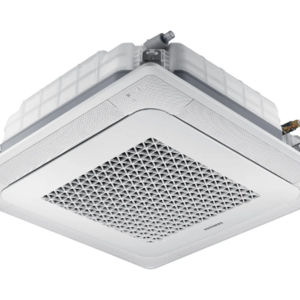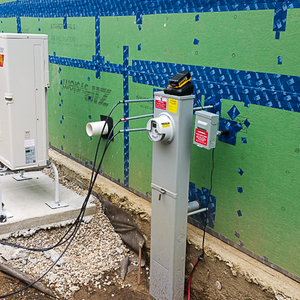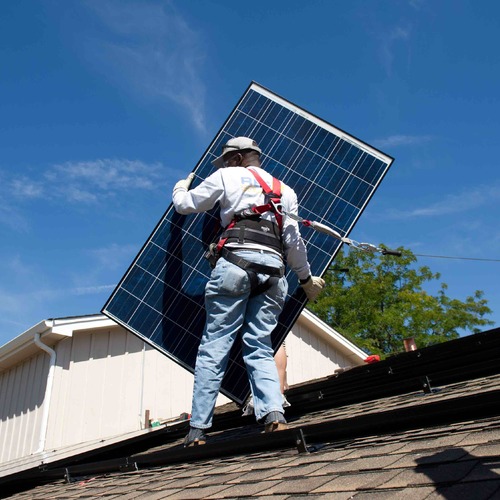
The ductless heat pump market is becoming highly competitive. As established contractors, we sometimes find ourselves bidding against small operators willing to install equipment for little more than wages. We also face pressure from customers who browse equipment prices online, then use this information to question our bids. (The apparent mismatch between equipment price and installed price has prompted some lively discussion on this site; see “Are Ductless Minisplits Overpriced?”) In order to remain competitive while still earning a fair profit, it’s important to understand and manage the true costs of a ductless installation.
When customers price out equipment online, they usually look up indoor and outdoor units, but ignore—or at least underestimate—the “balance of system” (BOS)—the other equipment and materials required for a fully functional installation. I first learned the acronym BOS from friends in the photovoltaic industry, where it’s used to refer to items like mounting racks, wire, conduit, and inverters—everything except the PV panels themselves. As the price of panels has plummeted, BOS components make up an ever larger portion of a PV system’s costs.
I have no reason to think that the cost of ductless equipment will be falling any time soon. In fact, the trend seems to be in the opposite direction; we recently got notice of double-digit price increases from one of our suppliers. Nevertheless, as I’ll explain below, the costs of BOS components are well worth paying attention to.
In a typical ductless minisplit installation, BOS may include:
Weekly Newsletter
Get building science and energy efficiency advice, plus special offers, in your inbox.

This article is only available to GBA Prime Members
Sign up for a free trial and get instant access to this article as well as GBA’s complete library of premium articles and construction details.
Start Free TrialAlready a member? Log in















20 Comments
Jon,
Thanks for the article. Along the lines of BOS equipment, how are you folks flashing your line sets out of the exterior wall (after exiting the wall sleeve)? Seems like most people just caulk the top of the line set cover. Doesn’t seem like that’s enough. I know there are a few prefab options but these are more challenging to use for retrofit walls. Thanks.
We fill the wall sleeve with foam, then install the lineset covers. We've never had a problem with this, especially since the wall sleeve pitches down toward the outdoors. There are some lineset flashing kits which we've considered but haven't tried. I could also see using peel and stick flashing, especially in exposed locations.
Jon,
I love this sort of transparency. The article mentions '$6,000 ductless job'. Are the CoGs (cost of goods) above for a $6,000 job?
It's sort of stunning, if so, because a 2-3 man crew can do two of these in a day, in my experience.
Yes, this would be for a single-head ductless job. I chose $6000 as a a typical cost in our area.
I think two in a day is possible, but it requires all kinds of things to align--moderate travel times, good site access, etc. If the crews are running a new electrical circuit themselves, I would say one system a day is more typical.
The costs of parts above adds up to a bit over $2000. So you're estimating $4,000 labor for less than a day's work, for a crew of 2 (or 3?)? Or $8,000 if you can pull off 2 installs in a day (I'm sure that's unusual). Admittedly this is skilled labor and requires specialized equipment, but hmm, I can see why there are questions about the cost of these installs. What am I missing?
Thank you for these numbers, it's very rare to see cost breakdowns like this. I am one of the doubting consumers that reads things on the internet I may not fully understand, and it's nice to see information from the installer's side. That said, based on several quotes I got locally, the BOS costs stated here would just be noise as the quotes were several times material costs for what I consistently read is a one day installation for new construction on a ductless system. I fully understand that labor is expensive and a warrantied install has value, but when I try to quantify those based on quotes I'm a bit shocked. What would the expected consumer cost be for this system installed in your area? 6k? For me the cheapest quote was over 8k, albeit with different units.
Is your quote per ductless head? Boston area I’ve gotten $6-8+ per head.
Will,
yes that seemed to be roughly in line with the quotes I got.
>Is your quote per ductless head? Boston area I’ve gotten $6-8+ per head.
In competitive bidding it should be cheaper than that (by quite a bit!) unless the construction boom means none of them are hungry right now.
For comparative pricing in Massachusetts filterable by location, contractor, and manufacturer, see:
https://www.masscec.com/cost-residential-air-source-heat-pumps
The median cost PER TON (not per head) for ductless systems logged by the CEC's program was under $4K. In recent years I've seen single zone 3/4 tonners and 1 ton Mitsubishis come in under $4K, a handful of years back I consulted on a project in Vinyardhaven (usually a more expensive than average location) with 6 zones/4 tons of Fujitsu multi split come in under $15K,. which is < $3.8K/ton, < $2.5K/head. Getting on to 4 years ago I consulted on a project in Arlington that ended up two Mitsubishi FH12s and an FH09 (separate units all) that came in around $12K (~$4K per head).
In general it's better to specify the equipment yourself (or hire a right-minded engineer to specify it) then solicit bids for that equipment. If you leave it up to the HVAC contractors the proposals and pricing are all over the place. The guy in Arlington had some truly INSANE proposals & prices from contractors before I pushed him into running the Manual-J, specified some equipment for him, and had him bid it out.
There were two contractors that came in the ~$12K range- he went with the one that he felt he communicated with better. One of the FH12s I had recommended to be an FH09, but the contractor convinced him the slightly better throw of the higher cfm blower was "worth it". I didn't necessarily agree with that theory, but didn't disagree strongly. Size-wise it gave him more cold-snap margin, and it didn't ultimately change the upfront cost or efficiency by very much.
wow Dana, those are great prices. It may be that there is just so much demand in my area. All of the hvac quotes for whole house installs from my contractor seemed to target the 30-40k range, then 10-20k in upgrades. In theory going ductless should save you thousands of dollars in labor, but it didn't seem to make a difference in qoutes. When I spec'd my own system and tried to get quotes, most people didn't even bother getting back to me, but the ones that did were about 8k per head. We are going to try to go the route of a self install and getting it professionally commissioned, and hopefully I won't have a horror story to post here after the fact.
Dana,
I’ve read your old posts about your co-workers project. Unfortunately, I think those prices are history. As you recommended I had energy vanguard perform my manual J/S. I had a reputable second opinion way in as well. I put bids out to 5 companies. FS6 x 2, FS09, KJ18 all 1:1. Relatively easy route to outside. MHK2 x 2. Quotes were low $20 to low $30s. I questioned the highest quote using the CEC data which came from a high end company that works with one of the engineer I got my second opinion from. He contacted CEC and they have now actually updated their website (you linked to above) after the high end HVAC company complained to CEC.
“MassCEC's rebate data shows heat pump costs increasing each year. This data only goes through the first part of 2019. MassCEC suggests filtering by the most recent years to get more representative data, but we expect that even cost data from 2018-2019 may not reflect today's market prices. “
“ The cost per single-head unit may be a more relatable metric; in 2018-2019, the average cost of a single-head heat pump in this data set was $5,140.
Costs vary significantly by region. For example, the average 2018-2019 cost for a single-head heat pump in Suffolk County was $6,474 and the average cost in Berkshire County was $4,115.”
Ive read almost all of your posts on HVAC and you would agree with me that I also don’t want to pay bottom for crap details and poor commissioning. Would you mind telling me what company did the work? I’m guessing even that company’s cost are much higher now.
>"I’ve read your old posts about your co-workers project. Unfortunately, I think those prices are history."
In this year's red hot market seems all construction pricing has hit the stratosphere (priced a 2x4 stud lately?), and heat pump installers would follow suit when they barely have enough time to bid the projects let alone install them. The unit costs of mini-splits haven't risen significantly, and when the superheated construction market chills a bit pricing should come back in line. It's simply not a very competitive market right now.
It's really not that hard to install a single head mini-split- when the contractors are hungrier and have more time, they won't be able to charge those margins, but it's hard to blame them for making hay while the sun shines. I've personally opted to put off several projects this year due to the frenzied state of the market.
It's not your imagination- prices are a bit out of control in the past year. On a project I was advising on in Sherborn MA multiple bids for Mitsubishi solutions were high enough that the homeowner went with a 4 ton WaterFurnace Series 7 instead, which after federal and state incentives came in "only" a few thousand more than a best in class air source heat pump solution would have (after state & local incentives), but it was still well north of $25K (all-in, post incentives).
On a project I'm currently advising on in Malden MA the first proposal was for a ducted 2.5 ton Fujitsu 30RGLX (2x oversized for the ~15,000 BTU/hr eventual heat load per the quickie Manual-J) for a bit more than $20K. The homeowner pushed back and it was adjusted to a 24RGLX for a hair under $20K. There is nothing complicating the installation of ducts- it's an 800' single story house with a rectangular footprint, above an unfinished open basement with decent ceiling height. I was recommending a 1.5 ton ducted Fujitsu or Midea, anticipating something in the $8-12K range, which would have been an uptick from similar systems bid a handful of years ago. The sticker shock has them rethinking continuing to heat with a gas boiler (not the circa 1930 original that's still there though), and using window AC, but that hasn't been quoted yet either. I'm still hopeful that the market will cool off and prices will return to earth before move-in day.
$6k would be typical installed cost for a system like this in our area, for a company that offers full warranty coverage, has a 24/7 service department, etc. For this piece, I was focusing on the materials costs, but there's also a whole conversation about the all the hidden costs of running an HVAC company. When you figure in direct and indirect labor costs, insurance, sales commissions, vehicles, office overheads, etc., you start to see how the net profits really aren't all that big. We're in rural Upstate NY, and I can definitely see how many of these costs would be higher in metropolitan areas like Boston.
Nice article. Costs are important if we want these systems to have a big impact.
I have a number of mini split systems installed in several houses, and have received numerous quotes over the years so I have a little bit of experience with them.
I fear that if there is no change in the cost structure of mini splits, these systems will never take hold (particularly in retrofit situations) in sufficient numbers to be more than a novelty or to make a meaningful dent in greenhouse gas emissions. In Asia I understand these systems are extremely cheap and therefor ubiquitous-. Unless we get to that level these systems will not have the impact we need towards efficiency. They just cost too much compared to alternatives and seem to be a bit more fragile over longer periods.
Nick, I wonder if the biggest difference with Asia may be the abundance of cheap natural gas here in the US, but there also seems to be a real lack of consumer knowledge. Bad experiences with reliability and winter bills with older heat pump models among the older population anecdotally also seems to be rampant. What's really amazing to me is that most homes in the US have air conditioning, and heat pumps are practically the same thing. It may also come down to how homes are build and managed in much of the US - truly custom home builds are a rarity, so the hvac system is often specc'd by a tract/spec home builder and likely going with whatever is most cost effective. You would think labor savings would make minisplits win out, but I'm not sure. I suspect that hvac contractors are charging more in many markets because they are still a rarity and are not charging less to install them. At least that seemed to be the case in my area.
I am using a couple of PTAC, packaged terminal air conditions, in the small extremely well insulated open-floor-plan house I am designing. I can do the install and any future replacements including the electrical circuit. Total lifetime cost of HVAC will be lower than just about anything. But, the esthetics wouldn't appeal to all.
In December, we had a 9K Fujitsu mini split installed in our garage/workshop in Maine for $3700 complete.
I imagine minisplit sales will soon be booming in the PNW and Canada as homeowners reconsider the need for a/c after this year’s brutal heat.
James,
Around me on Southern Vancouver island mini-splits are already the default choice on new buildings. This project of rental apartments is pretty typical with individual units on each balcony: https://www.glenvalleygrove.ca
Makes sense.
Log in or become a member to post a comment.
Sign up Log in